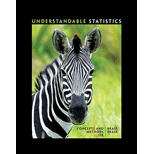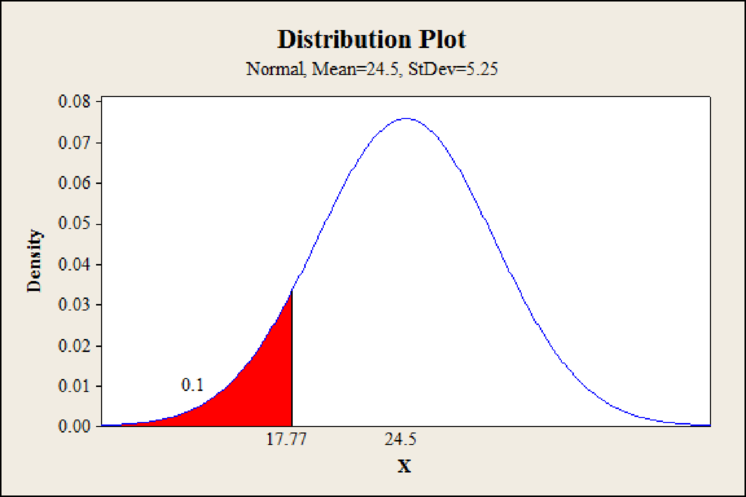
Concept explainers
(a)
Find the standard deviation of the x distribution.
(a)
Answer to Problem 34P
The standard deviation of the x distribution is 5.25 ounces.
Explanation of Solution
Calculation:
Rule of Thumb:
The formula for standard deviation using
In the formula, range is the obtained by subtracting the low value from the high value.
The variable x is a random variable that represents the weight (in ounces) of a healthy 10-week-old kitten.
The 95% of data range from 14 to 35 ounces.
The standard deviation is,
Hence, the standard deviation of the x distribution is 5.25 ounces.
(b)
Find the
(b)
Answer to Problem 34P
The probability that a healthy 10-week-old kitten would weigh less than 14 ounces is 0.0228.
Explanation of Solution
Calculation:
Z score:
The number of standard deviations the original measurement x is from the value of mean
In the formula, x is the raw score,
Substitute x as 14,
Use the Appendix II: Tables, Table 5: Areas of a Standard Normal Distribution: to obtain probability less than –2.
- Locate the value –2.0 in column z.
- Locate the value 0.00 in top row.
- The intersecting value of row and column is 0.0228.
The probability is,
Hence, the probability that a healthy 10-week-old kitten would weigh less than 14 ounces is 0.0228.
(c)
Find the probability that a healthy 10-week-old kitten would weigh more than 33 ounces.
(c)
Answer to Problem 34P
The probability that a healthy 10-week-old kitten would weigh more than 33 ounces is 0.0526.
Explanation of Solution
Calculation:
Substitute x as 33,
Use the Appendix II: Tables, Table 5: Areas of a Standard
- Locate the value 1.6 in column z.
- Locate the value 0.02 in top row.
- The intersecting value of row and column is 0.9474.
The probability is,
Hence, the probability that a healthy 10-week-old kitten would weigh more than 33 ounces is 0.0526.
(d)
Find the probability that a healthy 10-week-old kitten would weigh between 14 and 33 ounces.
(d)
Answer to Problem 34P
The probability that a healthy 10-week-old kitten would weigh between 14 and 33 ounces is 0.9246.
Explanation of Solution
Calculation:
Substitute x as 14,
Substitute x as 33,
Use the Appendix II: Tables, Table 5: Areas of a Standard Normal Distribution: to obtain probability less than –2.
- Locate the value –2.0 in column z.
- Locate the value 0.00 in top row.
- The intersecting value of row and column is 0.0228.
Use the Appendix II: Tables, Table 5: Areas of a Standard Normal Distribution: to obtain probability less than 1.62.
- Locate the value 1.6 in column z.
- Locate the value 0.02 in top row.
- The intersecting value of row and column is 0.9474.
The probability is,
Hence, the probability that a healthy 10-week-old kitten would weigh between 14 and 33 ounces is 0.9246.
(e)
Find the cutoff point for the weight of an undernourished kitten.
(e)
Answer to Problem 34P
The cutoff point for the weight of an undernourished kitten is 17.8 ounces.
Explanation of Solution
Calculation:
The weight is in the bottom 10% of the probability distribution of weights is called undernourished.
Step by step procedure to obtain probability plot using MINITAB software is given below:
- Choose Graph > Probability Distribution Plot choose View Probability > OK.
- Enter the Mean as 24.5, and Standard deviation as 5.25.
- From Distribution, choose ‘Normal’ distribution.
- Click the Shaded Area tab.
- Choose Probability and Left Tail, for the region of the curve to shade.
- Enter the Probability as 0.10.
- Click OK.
Output using MINITAB software is given below:

From Minitab output, the cutoff point for the weight of an undernourished kitten is 17.77.
Hence, the cutoff point for the weight of an undernourished kitten is 17.8 ounces.
Want to see more full solutions like this?
Chapter 6 Solutions
Understandable Statistics: Concepts and Methods
- Harvard University California Institute of Technology Massachusetts Institute of Technology Stanford University Princeton University University of Cambridge University of Oxford University of California, Berkeley Imperial College London Yale University University of California, Los Angeles University of Chicago Johns Hopkins University Cornell University ETH Zurich University of Michigan University of Toronto Columbia University University of Pennsylvania Carnegie Mellon University University of Hong Kong University College London University of Washington Duke University Northwestern University University of Tokyo Georgia Institute of Technology Pohang University of Science and Technology University of California, Santa Barbara University of British Columbia University of North Carolina at Chapel Hill University of California, San Diego University of Illinois at Urbana-Champaign National University of Singapore McGill…arrow_forwardName Harvard University California Institute of Technology Massachusetts Institute of Technology Stanford University Princeton University University of Cambridge University of Oxford University of California, Berkeley Imperial College London Yale University University of California, Los Angeles University of Chicago Johns Hopkins University Cornell University ETH Zurich University of Michigan University of Toronto Columbia University University of Pennsylvania Carnegie Mellon University University of Hong Kong University College London University of Washington Duke University Northwestern University University of Tokyo Georgia Institute of Technology Pohang University of Science and Technology University of California, Santa Barbara University of British Columbia University of North Carolina at Chapel Hill University of California, San Diego University of Illinois at Urbana-Champaign National University of Singapore…arrow_forwardA company found that the daily sales revenue of its flagship product follows a normal distribution with a mean of $4500 and a standard deviation of $450. The company defines a "high-sales day" that is, any day with sales exceeding $4800. please provide a step by step on how to get the answers in excel Q: What percentage of days can the company expect to have "high-sales days" or sales greater than $4800? Q: What is the sales revenue threshold for the bottom 10% of days? (please note that 10% refers to the probability/area under bell curve towards the lower tail of bell curve) Provide answers in the yellow cellsarrow_forward
- Find the critical value for a left-tailed test using the F distribution with a 0.025, degrees of freedom in the numerator=12, and degrees of freedom in the denominator = 50. A portion of the table of critical values of the F-distribution is provided. Click the icon to view the partial table of critical values of the F-distribution. What is the critical value? (Round to two decimal places as needed.)arrow_forwardA retail store manager claims that the average daily sales of the store are $1,500. You aim to test whether the actual average daily sales differ significantly from this claimed value. You can provide your answer by inserting a text box and the answer must include: Null hypothesis, Alternative hypothesis, Show answer (output table/summary table), and Conclusion based on the P value. Showing the calculation is a must. If calculation is missing,so please provide a step by step on the answers Numerical answers in the yellow cellsarrow_forwardShow all workarrow_forward
 Glencoe Algebra 1, Student Edition, 9780079039897...AlgebraISBN:9780079039897Author:CarterPublisher:McGraw Hill
Glencoe Algebra 1, Student Edition, 9780079039897...AlgebraISBN:9780079039897Author:CarterPublisher:McGraw Hill
